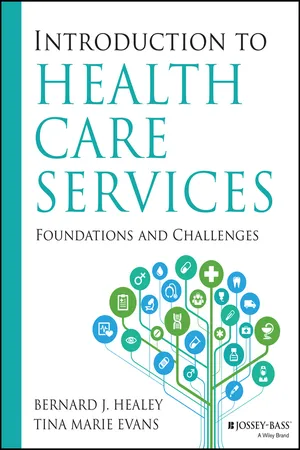
Introduction to Health Care Services: Foundations and Challenges
- English
- ePUB (mobile friendly)
- Available on iOS & Android
Introduction to Health Care Services: Foundations and Challenges
About this book
Introduction to Health Care Services: Foundations and Challenges offers new insights into the most important sectors of the United States' health care industry and the many challenges the future holds. Designed to provide a comprehensive and up-to-date understanding of the system, this textbook covers the many facets of health care delivery and details the interaction of health, environments, organizations, populations, and the health professions. Written by authors with decades of experience teaching and working in health care administration and management, the book examines the current state and changing face of health care delivery in the United States. Each chapter includes learning objectives and discussion questions that help guide and engage deeper consideration of the issues at hand, providing a comprehensive approach for students. Cases studies demonstrating innovations in the delivery of health care services are also presented.
Health care administration requires a thorough understanding of the multiple systems that define and shape the delivery of health care in the United States. At the same time, it is important for students to gain an appreciation of the dilemma confronting policy makers, providers, and patients in the struggle to balance cost, quality, and access. Introduction to Health Care Services: Foundations and Challenges is an in-depth examination of the major health care issues and policy changes that have had an impact on the U.S. health care delivery system.
- Includes information on U.S. health care delivery, from care to cost, and the forces of change
- Focuses on major industry players, including providers, insurers, and facilities
- Highlights challenges facing health care delivery in the future, including physician shortages, quality care, and the chronic disease epidemic
The U.S. health care system is undergoing major reform, and the effects will ripple across every sector of the industry. Introduction to Health Care Services: Foundations and Challenges gives students a complete introduction to understanding the issues and ramifications.
Frequently asked questions
- Essential is ideal for learners and professionals who enjoy exploring a wide range of subjects. Access the Essential Library with 800,000+ trusted titles and best-sellers across business, personal growth, and the humanities. Includes unlimited reading time and Standard Read Aloud voice.
- Complete: Perfect for advanced learners and researchers needing full, unrestricted access. Unlock 1.4M+ books across hundreds of subjects, including academic and specialized titles. The Complete Plan also includes advanced features like Premium Read Aloud and Research Assistant.
Please note we cannot support devices running on iOS 13 and Android 7 or earlier. Learn more about using the app.
Information
PART ONE
OVERVIEW OF HEALTH CARE SERVICE DELIVERY
Chapter 1
An Overview of Health Care Delivery in the United States
Learning Objectives
- Describe the major problems found in the U.S. health care delivery system.
- Describe the need for reform of the present system of health care delivery in the United States.
- Discuss how health care services are financed in the United States.
- Explain the advantages of a focus on health outcomes rather than activities in the health care delivery system.
- Demonstrate the value of preventing disease rather than mostly attempting to cure disease.
Patient Protection and Affordable Care Act of 2010 (ACA)
Health Care Costs
cost disease
Table of contents
- Cover
- Title Page
- Copyright
- Dedication
- Figures, Tables, and Exhibits
- Introduction
- Acknowledgments
- About the Authors
- About the Contributors
- PART ONE: OVERVIEW OF HEALTH CARE SERVICE DELIVERY
- PART TWO: THE MAJOR PLAYERS IN HEALTH CARE SERVICES
- PART THREE: CHALLENGES IN HEALTH CARE DELIVERY
- Case Study 1: Innovation in Physician Leadership Education
- Case Study 2: Using Marketing Tools to Increase Early Referrals of Children with Developmental and Behavioral Disorders
- Case Study 3: Fall Reduction at Geisinger Wyoming Valley Medical Center
- Case Study 4: The VA Reinvents Itself
- Index
- End User License Agreement